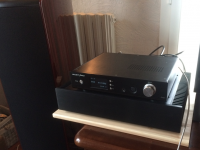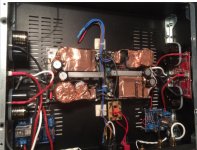Fluid,
I basically wanted to know if those heatsinks are big enough to handle the FO L at max power (for an extended period of time). Based on the images in message #3631, I have my doubts as LC is pairing a larger heatsink to his FO L's. (380x50x150).
--Lenard
Studley, FO L needs at least 0,33 K/W heatsink's thermal coefficient to set proper bias at +/-85 V SMPS. Fischer Elektronik SK159 or SK533 (100 mm lenght) are OK
This is what Andrej listed as needed, the Fisher part numbers mentioned there are very big heatsinks as the fins are 83.5mm deep instead of 40 to 50mm which is more usual for the ebay ones.
The one you mentioned should be within 0.33K/W but only just and it would seem that a little bit more might be better unless you lower the voltage rails or reduce bias.
The bias on the First One amps is quite high and saturates the heatsink, they don't get that much hotter when playing music from when they are up to temperature at idle. You also need to think if you will actually need the power that the FO L will produce other than for short bursts on peaks.
Do you really need
max power (for an extended period of time)?
This is not meant to be a PA amplifier to be hammered at 11 all day unless you put a really big heatsink on it or use active cooling.
I'm wondering what the output power would be of an L module if I powered it with a 1200A700 PS rather than the recommended 3KA700? I'm not sure how to work out the effect of the reduced output power of the PS. Advice welcomed.
New FO M will share the same front-end as it is present in FO L, meaning improvements to the FO M sound quality. FO L with Cap Banks has SQ better than most high-end amplifiers present on the market.
I'm lucky enough to have access to compare FO L to some best amplifiers in the industry. Lately we made head to head tests with these power amplifiers (mostly best models of brand named): Lamm 1.2 Reference, AVM monoblocks, Hegel, Electrocompaniet, MSB, Gryphon, Classe, Analog Domain, Rotel, ... etc.
Hi LC,
It is sad we lack mag reviews à la Stereoplay or Audio to evaluate where your nice modules rank in comparison to established references. I wonder if the M modules can cope with the amp section of say an integral amp à la Accuphase E470... Not the absolute best sound, but somewhere a nice known quantity of qualities around the world, easy to assess / compare to everywhere.
Anyway, in order to have a better idea of your sound preferences as amp designer, could you perhaps in a few bullet points name the exact amps your modules were compared to, and what the plus and minus were in your POV each time? That way one can figure out how you "trim" your amps sonicaly... and where you put the cursor re precision and musicality. For example, I know how "I find" some AVMs and Pass amps re precision and music flow, that's subjective but gives nevertheless an idea of what I like and at what level I want to play and when I find someone with similar likings and exigences I can assume what he likes could interest me aswell...
On another note, now that the M modules are a tad better (and a tad more expensive), how would you rate the sonic differences between the M and L modules... provided one needs in average only 2 to 15W output with max bursts in the 150W region (on impedances around 4 Ohms, min 3.2)? Is there still any gap or is it the same at low power outputs?
Thanks again for all your updates and interesting work
Claude
Fluid,
No, I don't need OP L's max continuous power as my speakers are only rated at 200W. In fact, running the OP L at +/-63V would be plenty.
By the way, thanks for your last remarks. It tied some loose ends for me. 🙂
--Lenard
No, I don't need OP L's max continuous power as my speakers are only rated at 200W. In fact, running the OP L at +/-63V would be plenty.
By the way, thanks for your last remarks. It tied some loose ends for me. 🙂
--Lenard
Save
I'm wondering what the output power would be of an L module if I powered it with a 1200A700 PS rather than the recommended 3KA700? I'm not sure how to work out the effect of the reduced output power of the PS. Advice welcomed.
They both have the same voltage output so the power output from the amp with 8 ohm loads should be very similar unless the smaller supply sags more under load.
The 1200A700 has a maximum peak of 1200 to 1500 Watts.
The 3kA700 has a maximum peak of 3000 to 3600 Watts depending on frequency.
The bigger supply has more current capability as it can supply more power at the same voltage. The bigger supply has many more capacitors onboard as the power output is higher.
Have a look at the datasheets if you need more info.
Fluid,
No, I don't need OP L's max continuous power as my speakers are only rated at 200W. In fact, running the OP L at +/-63V would be plenty.
By the way, thanks for your last remarks. It tied some loose ends for me. 🙂
--LenardSave
No problem glad I could help😉
Just because your speaker is rated at 200W (under what conditions?) doesn't mean you need an amplifier that can provide it.
Efficiency of the speaker is the number you need to work out how loud it will be for a given power input.
Even a fairly inefficient 85dB / W speaker will put out 100dB given 32 Watts, (double power for each 3dB increase).
That is pretty loud for hifi listening. Beyond that the power requirements go up quickly but you will probably reach the excursion limit or your tolerance limit before the amp gives out.
An amp like the FO L will be much better at powering a passive speaker with a horrible reactance / impedance curve as it has the current capability to do so.
It may also pay to check with LC if there is any similar thoughts on the input resistors if you choose to run the L at lower rail voltage.
Fluid,
I am planning to build the SB-10 since my condo has a full blown woodworking shop:
SBAcoustics 10
The OP M should be enough to handle the speakers but for 200 Euro more, the OP L modules are tempting and "future proof".
That said, I've been dragging my feet to see what kind of pricing LC's commercial amp offerings will have. Since he is selling directly, I'm hoping they will be competitively priced. If not, I'll go the FO DIY route.
--Lenard
I am planning to build the SB-10 since my condo has a full blown woodworking shop:
SBAcoustics 10
The OP M should be enough to handle the speakers but for 200 Euro more, the OP L modules are tempting and "future proof".
That said, I've been dragging my feet to see what kind of pricing LC's commercial amp offerings will have. Since he is selling directly, I'm hoping they will be competitively priced. If not, I'll go the FO DIY route.
--Lenard
Fluid,
I am planning to build the SB-10 since my condo has a full blown woodworking shop:
SBAcoustics 10
The OP M should be enough to handle the speakers but for 200 Euro more, the OP L modules are tempting and "future proof".
That said, I've been dragging my feet to see what kind of pricing LC's commercial amp offerings will have. Since he is selling directly, I'm hoping they will be competitively priced. If not, I'll go the FO DIY route.
--Lenard
Those are very nice speakers and Troels does an excellent job in designing them.
The 200w power handling quoted is for the woofer as that is it's long term thermal limit. But remember that the crossover will have to burn a lot of that as heat for the mid and tweeter.
This is the excursion of the SB29 driver in a 55 liter reflex box with an F3 of 27.5Hz as Troels has it. X-max is reached at 35Hz with 170 watts. X-max isn't reached again until 20 Hz but then cone control is completely lost. 170w will give you 111dB maximum output at 100Hz.
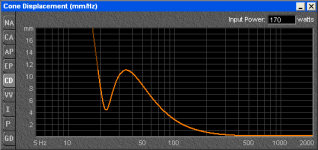
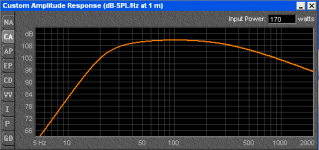
This speaker will be fine for music when given up to 170w but do not use it for movie effects without a high pass filter with 170w or your woofer will try to throw itself across the room.
The impedance is pretty benign and is quite low throughout it's range so if you use the FO M you will still have power left after your speaker has given out with a 4ohm load.
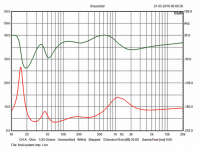
The First One L needs a big heatsink which means a big chassis, the First One M sits happily in a 300mm deep 80mm high chassis.
When you take into account the extra power supply, chassis/heatsink needed the price for the FO L will be quite a lot more than the extra for just the modules itself.
First One M is more than enough, but when has enough been enough? 😀
Those are very nice speakers and Troels does an excellent job in designing them.
The 200w power handling quoted is for the woofer as that is it's long term thermal limit. But remember that the crossover will have to burn a lot of that as heat for the mid and tweeter.
This is the excursion of the SB29 driver in a 55 liter reflex box with an F3 of 27.5Hz as Troels has it. X-max is reached at 35Hz with 170 watts. X-max isn't reached again until 20 Hz but then cone control is completely lost. 170w will give you 111dB maximum output at 100Hz.
View attachment 595816 View attachment 595817
This speaker will be fine for music when given up to 170w but do not use it for movie effects without a high pass filter with 170w or your woofer will try to throw itself across the room.
The impedance is pretty benign and is quite low throughout it's range so if you use the FO M you will still have power left after your speaker has given out with a 4ohm load.
View attachment 595818
The First One L needs a big heatsink which means a big chassis, the First One M sits happily in a 300mm deep 80mm high chassis.
When you take into account the extra power supply, chassis/heatsink needed the price for the FO L will be quite a lot more than the extra for just the modules itself.
First One M is more than enough, but when has enough been enough? 😀
Great explanation FLUID 🙂 Thank you! I had the same hesitation going on, whether to build M or L module amp for the planned Troels SBA 10 build. Now I'm absolutely convinced that M will do just fine 🙂
Fluid,
Thanks for the extra info on the SBA-10's woofer. I exchanged a few emails with Mr. Gravesen and he was very, very pleased with how the project turned out.
With regards to your comments:
There is no price difference going from the 2xSMPS1200A400 to 2xSMPS1200A700.....or is the latter the wrong PSU's to use? Going from a 2U to a 3U DISSIPANTE is only about $50 or so at the DIYAUDIOSTORE.
--Lenard
Thanks for the extra info on the SBA-10's woofer. I exchanged a few emails with Mr. Gravesen and he was very, very pleased with how the project turned out.
With regards to your comments:
When you take into account the extra power supply, chassis/heatsink needed the price for the FO L will be quite a lot more than the extra for just the modules itself.
There is no price difference going from the 2xSMPS1200A400 to 2xSMPS1200A700.....or is the latter the wrong PSU's to use? Going from a 2U to a 3U DISSIPANTE is only about $50 or so at the DIYAUDIOSTORE.
--Lenard
With regards to your comments:
There is no price difference going from the 2xSMPS1200A400 to 2xSMPS1200A700.....or is the latter the wrong PSU's to use? Going from a 2U to a 3U DISSIPANTE is only about $50 or so at the DIYAUDIOSTORE.
--Lenard
The power supplies you list cost the same, but the SMPS1200 is recommended for the FO M and the SMPS 3K is recommended for the FO L. The 3K is more expensive. 400 vs 700 is the change in voltage from 63 to 85.
A 3U (300mm) Dissipante only has a 0.4 C/W rating and you need it to be at least 0.33C/W. The 4U (300mm) Dissipante has a 0.31 C/W rating and is 40 Euro more plus it is heavier so I don't know if that makes shipping more expensive. The other choice would be a 3U that is 400mm deep as that will be closer to 0.25C/W (same price as 4U 300).
So by my calculations 2 x 3K power supplies are 120 Euro more plus 40 extra for the chassis is 160 euro extra plus the difference in cost of the modules.
You can use whichever supply or chassis you want to save money but to me it makes no sense to use the bigger modules and then use a smaller supply and marginal chassis.
It makes more sense to me to use the L with the bigger supply and bigger chassis to make use of it's potential or use the M with the smaller supply and smaller chassis. But it's not my choice 😉
The speakers you intend to use are effectively 4 ohm throughout the bass region so the FO M at 63V can give you up to 240 Watts which is more than the SBA 10 can take before reaching linear excursion limits.
Great explanation FLUID 🙂 Thank you! I had the same hesitation going on, whether to build M or L module amp for the planned Troels SBA 10 build. Now I'm absolutely convinced that M will do just fine 🙂
No problem, glad it helped 🙂
It makes more sense to me to use the L with the bigger supply and bigger chassis to make use of it's potential or use the M with the smaller supply and smaller chassis. But it's not my choice 😉
It makes sense to me too. Thanks Fluid!
Hi There !
a new FO 1.4M in 2U chassis is alive and kicking 😀
it was done during summer by a friend following my recommendation , and I ve managed to upgrade it.
- more caps, doubling the original 2m2, which provides a 6db better rejection of the 100hz ripple from the smps (you may have some old FO1.2 in trays. unsoldering caps is quite difficult but doable)
- finally a bigger smps (DPS400/S2) in 52V as I didn't get enough juice out of the FO with the previous 45V smps (see previous posts)
- shielding and grounding a bit the SMPS
- replacing the RCA twisted pair by a proper 2+shield silver cable
the shield is connected to the SMPS gnd and NOT to the in-. so the 2 cables inside the shields goes straight from in-/in+ to the RCA hot+cold. This lowers overall noise figures.
Now with this 52V smps I can get a very powerful and clean 150watts into 4ohms load (25Vrms, but no more). this is with 28ma vas bias. with 230ma overall bias, heatsink stabilizes at 42°C and can go to 47 during huge listening session with lots of bass 😛
here are 2 picture of the insitu and inside.
Also I ve made a whole set of measurement to check the output power (wanted to check limits before clipping) and the smps behavior and this is all inside a PDF file available here: https://drive.google.com/file/d/0B5D8h5jG85DiTWVKTHBkYTI1UGc/view?usp=sharing
I m amazed by the extremely low noise (input shorted) at around 17uV rms for one module... (I thought there was a mistake during measurement!)
In the same time I have also made lots of tests (bench+listen) with a pair of ucd400, but with a single poor smps400a400. of course FO was the winner. UCD shows some 100hz jitter around fundamental which FO doesn't have.
Listening experience is really fantastic. I love how this combo (smps+fo) is able to trough clean and very powerful bass into the room. this brings live into the recording. and finally the voices are warm (even warmer when FO is hot) but maybe FO is just revealing the gustard perf 😱 (I m using "super slow" filter which reduces highs)
cheers / enjoy your FO experience
a new FO 1.4M in 2U chassis is alive and kicking 😀
it was done during summer by a friend following my recommendation , and I ve managed to upgrade it.
- more caps, doubling the original 2m2, which provides a 6db better rejection of the 100hz ripple from the smps (you may have some old FO1.2 in trays. unsoldering caps is quite difficult but doable)
- finally a bigger smps (DPS400/S2) in 52V as I didn't get enough juice out of the FO with the previous 45V smps (see previous posts)
- shielding and grounding a bit the SMPS
- replacing the RCA twisted pair by a proper 2+shield silver cable
the shield is connected to the SMPS gnd and NOT to the in-. so the 2 cables inside the shields goes straight from in-/in+ to the RCA hot+cold. This lowers overall noise figures.
Now with this 52V smps I can get a very powerful and clean 150watts into 4ohms load (25Vrms, but no more). this is with 28ma vas bias. with 230ma overall bias, heatsink stabilizes at 42°C and can go to 47 during huge listening session with lots of bass 😛
here are 2 picture of the insitu and inside.
Also I ve made a whole set of measurement to check the output power (wanted to check limits before clipping) and the smps behavior and this is all inside a PDF file available here: https://drive.google.com/file/d/0B5D8h5jG85DiTWVKTHBkYTI1UGc/view?usp=sharing
I m amazed by the extremely low noise (input shorted) at around 17uV rms for one module... (I thought there was a mistake during measurement!)
In the same time I have also made lots of tests (bench+listen) with a pair of ucd400, but with a single poor smps400a400. of course FO was the winner. UCD shows some 100hz jitter around fundamental which FO doesn't have.
Listening experience is really fantastic. I love how this combo (smps+fo) is able to trough clean and very powerful bass into the room. this brings live into the recording. and finally the voices are warm (even warmer when FO is hot) but maybe FO is just revealing the gustard perf 😱 (I m using "super slow" filter which reduces highs)
cheers / enjoy your FO experience
Attachments
Last edited:
Bravo Maxidcx, nice built of yours!
And thanks for sharing all these useful measurements.
I can also see you did some clever shielding around your SMPS
What relay board are you using as output protection?
Bonne musique pour longtemps
Claude
And thanks for sharing all these useful measurements.
I can also see you did some clever shielding around your SMPS
What relay board are you using as output protection?
Bonne musique pour longtemps
Claude
your welcome 🙂
the protection is this one : http://www.audiophonics.fr/en/softs...1237-protection-pour-haut-parleur-p-8203.html
using one per chanel to avoid ground loop. and it is powered by an auxiliary output from the smps (20volt or so)
the protection is this one : http://www.audiophonics.fr/en/softs...1237-protection-pour-haut-parleur-p-8203.html
using one per chanel to avoid ground loop. and it is powered by an auxiliary output from the smps (20volt or so)
Last edited:
Hi maxi, nice set of measurements, thanks and congratulations for your help to your friend to get one of the best sounding little amp on the market. I'm sure First One amp allows Gustard A20H to show its full potential, especially in a system consisting good loudspeakers.
As said many times, FO module implemented in correct way in an earthed metal chassis is dead quiet, no noise could be heard from the tweeter, also the mains frequency is well suppressed.
New FO M module, now sharing all the best features from FO L, is just a bit better in noise and THD measurements, not to mention soundwise too. Decision to go on the same sound quality level with all module variants, only different power ratings, is very important since people do use them in an active systems, bi-amping systems, multichannel HT systems, etc.
Enjoy, L.C.
As said many times, FO module implemented in correct way in an earthed metal chassis is dead quiet, no noise could be heard from the tweeter, also the mains frequency is well suppressed.
New FO M module, now sharing all the best features from FO L, is just a bit better in noise and THD measurements, not to mention soundwise too. Decision to go on the same sound quality level with all module variants, only different power ratings, is very important since people do use them in an active systems, bi-amping systems, multichannel HT systems, etc.
Enjoy, L.C.

Everything is exactly the same as per FO M calibration, same procedure to the last detail as described in User and installation manual.Hi LC,
Is there any manual for FO 1.4L ?
Mainly, instructions for the calibration.
Thanks
Only trimmer TR3 which sets bias current ie. power supply current of the module, could be rotated CW (clockwise) to set bias current to a higher value: anything in between 280 mA up to 500 mA. Correct bias value (TR3 position) is set when heatsink reaches 45 °C in idle (power on, no input signal).
I'm wondering what the output power would be of an L module if I powered it with a 1200A700 PS rather than the recommended 3KA700? I'm not sure how to work out the effect of the reduced output power of the PS. Advice welcomed.
Well SMPS1200 has less output current capability, also its output current limit protection is set to lower level as in SMPS3k. Output voltage drop ie. output impedance is much lower at SMPS3k, which is obvious comparing both datasheets. For no compromise designs I will always recommend two SMPS3kA700 in dual mono arrangement for FO L. Same question about power supply selection is present from the first post of this thread and I admit that I did not check each and everyone of them. I can just say what I tried and what I recommend and that is:
- SMPS1200A400 one per one FO M module
- SMPS3kA700 one per one FO L module
Cap Bank modules added will also bring noticable sound improvement.
Last edited:
- Home
- Vendor's Bazaar
- First One - mosFET amplifier module
